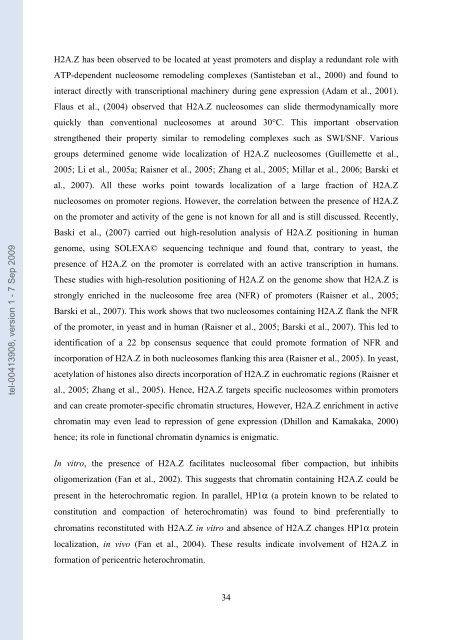Etudes sur le mécanisme de remodelage des nucléosomes par ...
Etudes sur le mécanisme de remodelage des nucléosomes par ...
Etudes sur le mécanisme de remodelage des nucléosomes par ...
You also want an ePaper? Increase the reach of your titles
YUMPU automatically turns print PDFs into web optimized ePapers that Google loves.
tel-00413908, version 1 - 7 Sep 2009<br />
H2A.Z has been observed to be located at yeast promoters and display a redundant ro<strong>le</strong> with<br />
ATP-<strong>de</strong>pen<strong>de</strong>nt nuc<strong>le</strong>osome remo<strong>de</strong>ling comp<strong>le</strong>xes (Santisteban et al., 2000) and found to<br />
interact directly with transcriptional machinery during gene expression (Adam et al., 2001).<br />
Flaus et al., (2004) observed that H2A.Z nuc<strong>le</strong>osomes can sli<strong>de</strong> thermodynamically more<br />
quickly than conventional nuc<strong>le</strong>osomes at around 30°C. This important observation<br />
strengthened their property similar to remo<strong>de</strong>ling comp<strong>le</strong>xes such as SWI/SNF. Various<br />
groups <strong>de</strong>termined genome wi<strong>de</strong> localization of H2A.Z nuc<strong>le</strong>osomes (Guil<strong>le</strong>mette et al.,<br />
2005; Li et al., 2005a; Raisner et al., 2005; Zhang et al., 2005; Millar et al., 2006; Barski et<br />
al., 2007). All these works point towards localization of a large fraction of H2A.Z<br />
nuc<strong>le</strong>osomes on promoter regions. However, the correlation between the presence of H2A.Z<br />
on the promoter and activity of the gene is not known for all and is still discussed. Recently,<br />
Baski et al., (2007) carried out high-resolution analysis of H2A.Z positioning in human<br />
genome, using SOLEXA© sequencing technique and found that, contrary to yeast, the<br />
presence of H2A.Z on the promoter is correlated with an active transcription in humans.<br />
These studies with high-resolution positioning of H2A.Z on the genome show that H2A.Z is<br />
strongly enriched in the nuc<strong>le</strong>osome free area (NFR) of promoters (Raisner et al., 2005;<br />
Barski et al., 2007). This work shows that two nuc<strong>le</strong>osomes containing H2A.Z flank the NFR<br />
of the promoter, in yeast and in human (Raisner et al., 2005; Barski et al., 2007). This <strong>le</strong>d to<br />
i<strong>de</strong>ntification of a 22 bp consensus sequence that could promote formation of NFR and<br />
incorporation of H2A.Z in both nuc<strong>le</strong>osomes flanking this area (Raisner et al., 2005). In yeast,<br />
acetylation of histones also directs incorporation of H2A.Z in euchromatic regions (Raisner et<br />
al., 2005; Zhang et al., 2005). Hence, H2A.Z targets specific nuc<strong>le</strong>osomes within promoters<br />
and can create promoter-specific chromatin structures, However, H2A.Z enrichment in active<br />
chromatin may even <strong>le</strong>ad to repression of gene expression (Dhillon and Kamakaka, 2000)<br />
hence; its ro<strong>le</strong> in functional chromatin dynamics is enigmatic.<br />
In vitro, the presence of H2A.Z facilitates nuc<strong>le</strong>osomal fiber compaction, but inhibits<br />
oligomerization (Fan et al., 2002). This suggests that chromatin containing H2A.Z could be<br />
present in the heterochromatic region. In <strong>par</strong>al<strong>le</strong>l, HP1α (a protein known to be related to<br />
constitution and compaction of heterochromatin) was found to bind preferentially to<br />
chromatins reconstituted with H2A.Z in vitro and absence of H2A.Z changes HP1α protein<br />
localization, in vivo (Fan et al., 2004). These results indicate involvement of H2A.Z in<br />
formation of pericentric heterochromatin.<br />
34

















